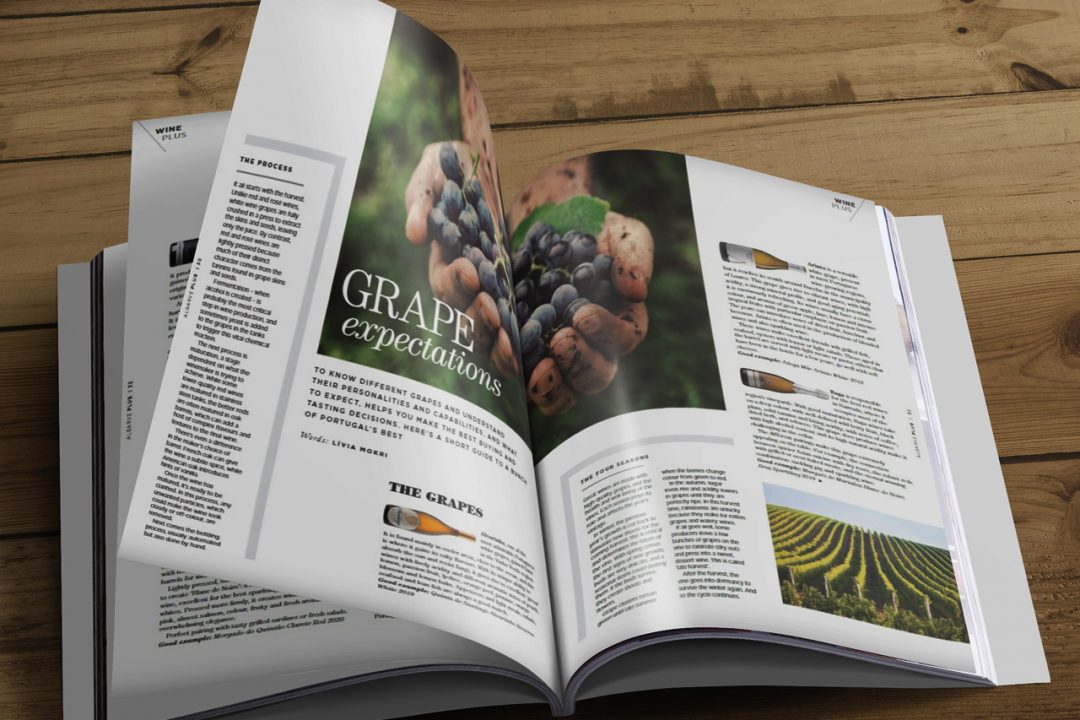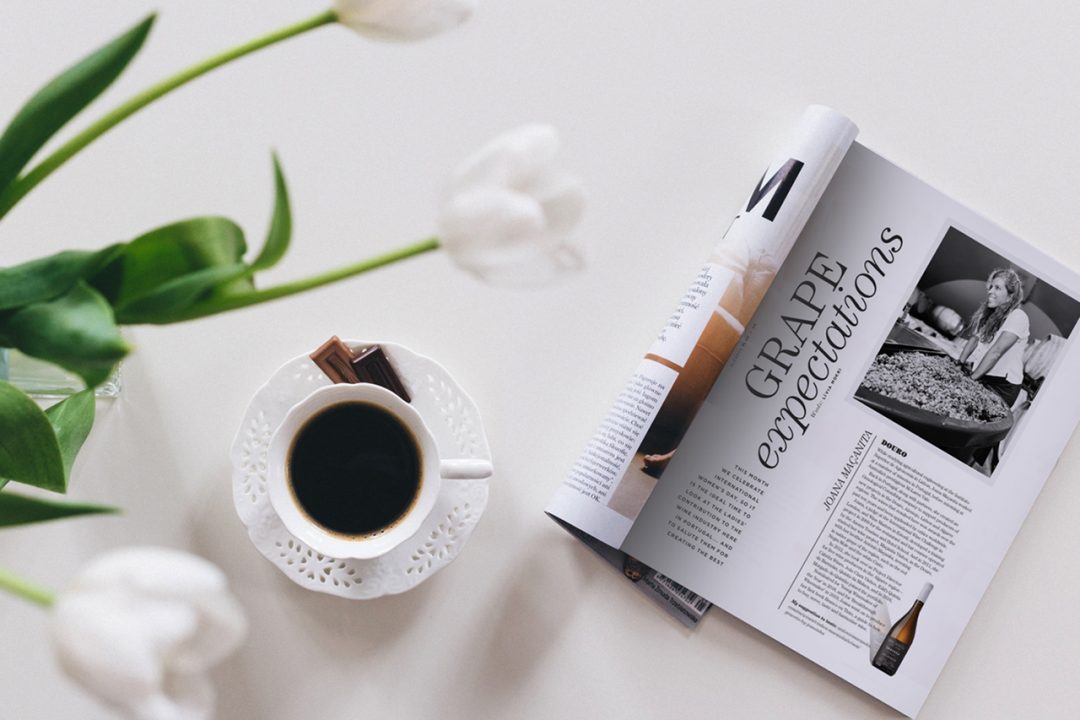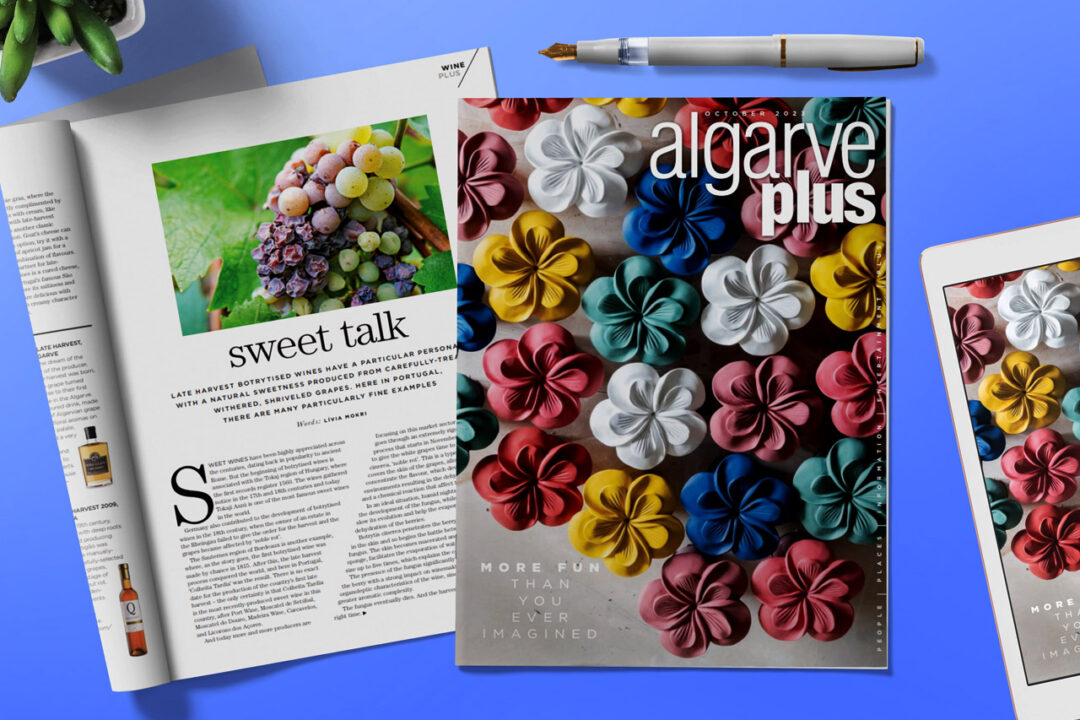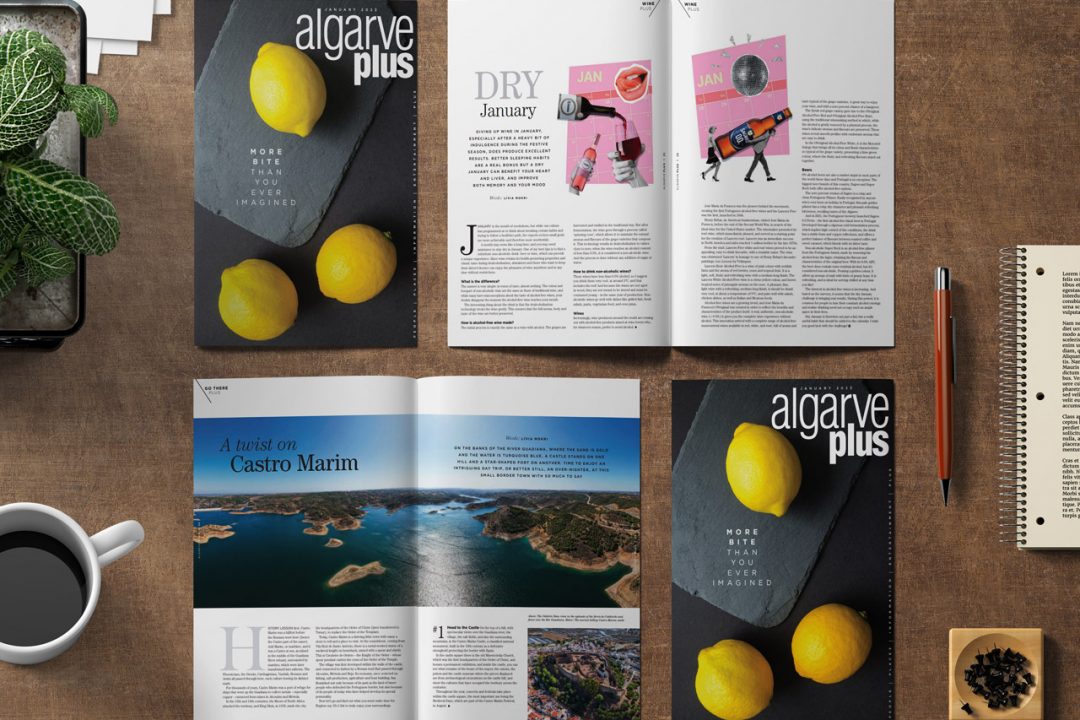Grape expectations –To know different grapes and understanding their personalities and capabilities, and what to expect, helps you make the best buying and tasting decisions. Meet a short guide to a bunch of Portugal’s best.
I am happy to share that the June issue of the Algarve Plus Magazine has already been published, with my new article!
If you want to understand the grapes themselves, head to my article in the online magazine below.
And if you need a professional wine tour guide, feel free to contact me and I’ll be happy to help you to understand the Algarve wines!
The magazine is readable online or downloaded for free here.
Enjoy!
Or read here the whole article:
Grape expectations
For many, the craft of winemaking is a life-long dream. On the surface, the process looks simple: you gather grapes, throw them in a tank and then wait some time for the wine. However, in truth, this job is not so easy.
But what is winemaking really like? Let’s walk through its essential steps, including the difference between making red and white wines to help you appreciate wine even more.
How Wine Is Made
It all starts with the harvest, picking the grapes by hand, or using a picking machine. The white ones are usually picked before red ones, while they have plenty of acidities. Once the grapes are picked, stems and all, they are then transported for crushing, putting through a machine which destems the grapes.
And the next step greatly differs. Unlike red and rosé wines, white wine grapes are fully crushed in a press to extract the skins and seeds from the grape, leaving only the grape juice. By contrast, red and rosé wines are only lightly pressed because many of red wine’s qualities and character come from the tannins found in grape skins and seeds.
Fermentation is probably the most critical step in wine production — it’s when alcohol is created. To trigger this chemical reaction, sometimes yeast is added to the grapes in the tanks, which converts the grape sugars into alcohol.
For red and rosé wines, the grapes ferment with their skins on, giving them that iconic red color.
The next process is maturation, which period mostly depends on what the winemaker is trying to create.
While some lower-quality red wines are matured in stainless steel tanks, red wine is often matured in oak barrels, which can add a host of complex flavors and textures to wine.
French oak and American oak are the two most popular barrels. French oak can give the wine a subtle spice, while American oak mostly can give off hints of vanilla.
Once the wine has matured, it’s ready to be clarified. In this process, any unwanted particles are removed from the wine, which could make it look cloudy or off-color.
And the next step is the bottling. This process is commonly automated or can be done by hand. Then the bottle is sealed with a cork or screw caps.
As you can see, winemaking is not an easy job where much can go wrong. It takes years of knowledge for the producer to press, ferment and mature the grape into one of the world’s favorite drinks. So, the next time you take a sip of any wine, raise your glass and toast the winemakers of the world.
The grapes
Great wines are made with high-quality grapes. Now, let’s take a look at the life cycle of a grapevine and learn how each season affects the year’s vintage.
In winter the last year’s growth is cut back to grow new shoots for the coming year’s harvest. This is a critical moment that determines the future of the vine.
In spring, the first signs of new growth occur in the vineyard. Buds are very delicate, the spring hailstorm even can destroy them. If they survive, they create shoots and flowers.
Grape clusters remain green until late summer when the berries change color from green to red.
For autumn, sugar levels rise and acidity lowers in grapes until they are perfectly ripe. In this harvest time, rainstorms are unlucky because they make for watery wines and rotten grapes.
If all goes well, some producers leave a few bunches on the vine to raisinate (dry out) and press into a sweet, dessert wine. This is called ‘late harvest’.
And after the harvest, the vine goes into dormancy to survive the winter again.
Knowing the grapes helps you to choose the best wine in shops. So, let me give you now a short guide on what you can expect from a few best grapes in Portugal.
Alvarinho
Alvarinho is one of the most admirable Portuguese white grapes, is surely one of Portugal’s greatest treasures that gained fame especially in the Vinho Verde region. It is mainly found in cooler areas, close to the ocean, and this is why it gains its salty flavors. Unique ability to absorb the sun and resist fungi. It gives rise to excellent ‘green’ wines with lively acidity and different aromatic notes of peach, lemon, passion fruit, lychee, orange peel, jasmine, orange blossom and lemon balm. Appetizers and light meals, salads, seafood and low-fat fish are always a good match.
Good example: Quinta de Santiago Alvarinho Reserve White 2019
Arinto
Arinto is a versatile white variety, present in most Portuguese wine-growing regions, but it reaches its zenith in the Bucelas of the Lisboa region. It is being recognized by the name Pedernã in the Vinho Verde region. The firm acidity is the main business card of Arinto. This grape gives rise to vibrant wines, with high acidity, a strong mineral profile, enormous refreshing capacity, and good aging potential. It usually has an open citrus color with aromas of green apple, lime, lemon and intense tropical fruits with particular emphasis on passion fruit. The years can bring other notes of dried fruit, hazelnut, and beeswax.
Arinto is often used in the production of blended wines and also sparkling wines.
These wines are an excellent pairing with grilled fish, seafood, and oysters with lemon or light salads. Ones aged in the barrel are served with light meats or pasta. And those that have already been in the bottle for a few years, try with soft cheeses.
Good example: Adega Mãe Arinto White 2018
Baga
The capricious Baga is responsible for the best red wines in Bairrada, where it occupies most of the region’s vineyards.
With good maturation, Baga wines take on a deep color, with well-defined wild berry fruit, black plum, solid tannins and biting acidity, with notes of coffee, dried herb, and tobacco. This grape does not give wines with high alcohol content and has a high natural acidity making it challenging in the cellar.
The different pairings make this grape extremely appealing on the table. For example, the connection between spicier Asian cuisine with dry rosés and high acidity, the robust reds with grilled or oven-baked meats, and the eternal winning combination: suckling pig and sparkling wine.
And, if we talk about sparkling wines, we cannot exclude the beautiful Bairrada white and rosé sparklings made of Baga, with their beautiful creaminess and minerality provided by the calcareous soils.
Good example: Marquês de Marialva Blanc de Noirs Brut Sparkling 2019
Touriga Nacional
Touriga Nacional is the queen red grape in Portugal. It comes from the north, namely Dão where it is responsible for producing wines of immense finesse and elegance. However, it quickly gained national representation also in the Douro, where originally used in Port wines, but this increasingly important Portuguese grape is now featured in single-varietal red wines and blends as well.
As a late-maturing variety, it is one of the last to be harvested. Even so, it guarantees good levels of acidity and freshness. It is capable of producing balanced wines, with good alcohol levels and excellent aging potential. Its thick skin, rich in coloring matter, helps to obtain the intense, deep color of wines.
The abundance of aromas is one of the hallmarks of the variety, presenting simultaneously floral and fruity notes, which are always intense and explosive. It presents the characteristic aromas of violets, bergamots, wild berries, rockrose, and some notes of pine needles.
Good example: Maçanita Touriga Nacional Cima Corgo Red 2017
Castelão
This red variety spreads throughout the country, but it is in the old vineyards of the Palmela region in Setúbal that the variety gives its best. Historically, it was José Maria da Fonseca who plant this grape in Setúbal, which contributed most to the notoriety of Castelão. He was who created the red wine the name of Periquita, which became the first bottled red wine in Portugal and the oldest Portuguese brand marketed, the perfect example of the virtues and peculiarities of the grape.
Castelão produces structured and fruity wines, with a particular focus on currants, plums in syrup, and wild fruits. Wines from Castelão have prominent tannins with intense acidity, strong garnet tones, and an intense fruity aroma.
Good example: Periquita Reserve Red 2019
Negra Mole
Negra Mole is a red, emblematic, and unique grape, in fact, this is an Algarve grape variety, it was born here and it is in this region that it is the queen of grapes. The other curiosity of Negra Mole is to be the only variety in Portugal that can ripen in white or red grapes.
The grape is not to be confused with the Tinta Negra grapes used for Madeira wine, although they have many similarities with each other.
Its wines are rich in alcohol, with little fixed acidity, and poor in tannins. Complex wines with fruity aromas, and wood-giving structures by aging in wood for months.
Pink to ruby-colored wines, with a pleasant aromatic profile.
Lightly pressed, it produces white must, to create ‘Blanc de Noir’: a super fresh, mineral, and saline wine, excellent for the best sparkling bases or for gastronomic whites.
Pressed more firmly, they produce wines with pale pink (almost salmon) color, fruity and fresh aromas, and overwhelming elegance.
Perfect pairing with tasty grilled sardines or fresh salads.
Good example: Morgado do Quintão Clarete Red 2020
Encruzado
The cultivation of the white Encruzado variety is practically exclusive to the Dão area, being probably the best white variety planted in the region. It is used in the production of most white blended or single-varietal wines.
Encruzado gives aromas of roses and violets, light citrus notes, a little resin, and intense mineral notes with well-balanced sugar and acidity to the wines. These are serious, structured, unctuous wines with an extraordinary aging capacity.
Good example: Quinta de Cabriz Encruzado Reserve White 2019
Fernão Pires
It is one of the most planted white grape varieties in Portugal, planted widely throughout the country.
White variety, also called Maria Gomes, is revealed by its aroma of Muscat and some notes of roses and lychees. It produces fresh and very aromatic wines with low acidity. The wines of the variety can exhibit citrus notes such as orange, lime, or lemon, as well as floral aromas, such as linden, mimosa, and rose, as well as herbs or basil.
As a rule, Fernão-Pires wines should be drunk young.
Its extreme versatility allows it to be used in monovarietal, sparklings, and even in late-harvested, to obtain sweet wines. The wines from the Fernão Pires variety are extremely fragrant, and exuberant in aromas, seduction, and charm.
Good example: Tyto Alba 1836 Grand Reserve White 2017






No Comments Found